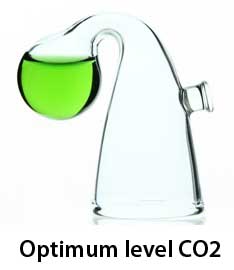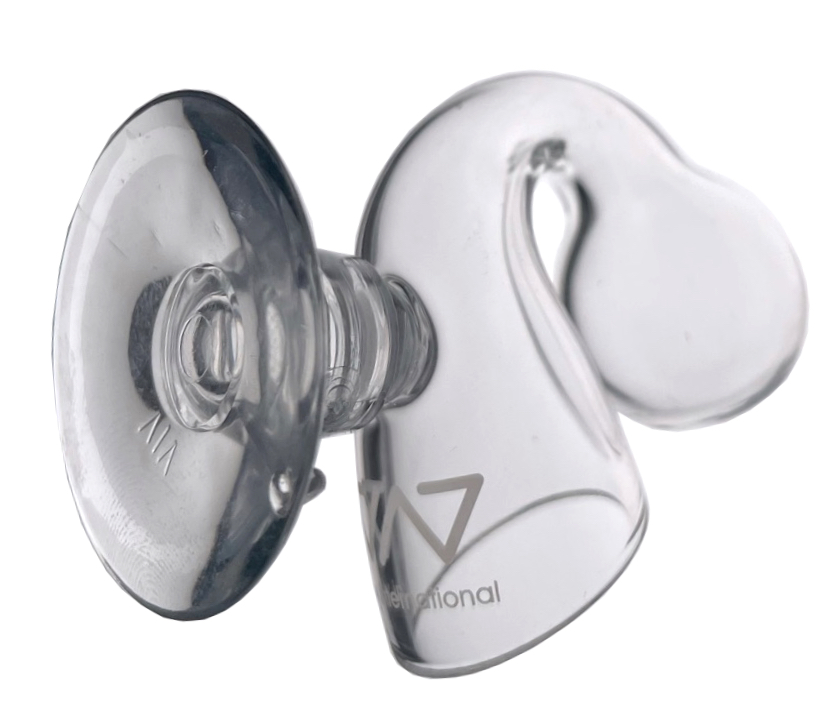Monitoring and maintaining the correct CO2 levels in a planted aquarium is vital. The drop checker is a reservoir for a colored fluid that indicates whether there is too much, too little, or the correct level of CO2 for plants to grow, and that is a safe level for the fish.
Invert your drop checker and fill the reservoir halfway with the CO2 drop checker indicator solution for glass models. On models such as the UP Aqua Long Term, remove the plastic cover and fill to the line.
Using the suction cup (or hang if using a hanging type), submerge the drop checker into your aquarium water and attach it to the aquarium glass sides for cushion cup models.
Water flow matters. For the drop checker to offer measurements of the CO2 in the tank that are meaningful, a good mix of water must be present. Good water circulation is critical for the planted aquarium, as many problems with CO2 come from a lack of mixing. Use the drop checker in different tank locations to see if the water is well mixed in CO2. In general terms, it is good to put the drop checker in an area with good water circulation for a more accurate result of the amount of CO2 injected into the tank.
Important note: Never put the drop checker in a dead zone regarding water circulation, as it will not provide readings accordingly with the CO2 you inject.
Based on the concentration of CO2 in the water, the color of the solution will change.
Check the color. Blue = too little CO2 concentration, Yellow = too much CO2 (dangerous levels for fish), and Green = optimum levels for plants and fish. The color has a 1-2 hour delay. So you were reading the CO2 concentration roughly 1-2 hours ago.



Based on the reading, adjust the CO2 bubble rate using a regulator if required and or the needle valve. Wait for 1.5 to 2 hours for the concentration of CO2 to change, and check your readings.
A general guide is between 1 – 3 bubbles per second through the bubble counter is usually enough to get a green reading on tanks up to 50 gallons. Adjust this according to the tank size and what the drop checker is indicating.
If there are problems getting a reading, the CO2 may not have been diffused enough in the water. Try adjusting or increasing tank circulation or re-positioning the diffuser towards the direction of flow to aid diffusion rates. Alternatively, positioning the diffuser near the filter inlet will allow the bubbles to travel through the filter, increasing the effectiveness of CO2 diffusion. The goal is to keep the bubbles in the water column for as long as possible to increase the effectiveness of CO2 diffusion in the aquarium water. Make minor adjustments until you get a green reading on the drop checker. Be careful not to go too high, as it can harm the fish. If this happens, add aeration with an airstone via an air pump and temporarily stop CO2 injection.

CO2 Glass Drop Checkers & CO2 Indicators
• Most favored hand-blown glassware in the aquatic world
• Allows you to monitor the CO2 level inside your aquarium
• Designed to hang on glass
• Easy to use
VIV’s hand-blown Glassware is the most favored in the aquatic world, offering an outstanding elegance to any aquarium. Designed to emphasize functional beauty, each VIV glass piece is handmade in Hong Kong by skilled glass workers. The details are formed from crystal clear borosilicate glass, the same material used to make high end lab equipment. Japanese glass artisans carefully hand finish each VIV part to the highest standards with smooth edges and attention to the finest details.
Use with UP Aqua CO2 Indicator Solution Refill for Drop Checker
FAQ: Must the drop checker have a fixed carbonate hardness (kH) to show the correct results? The question is entirely valid. kH is critical to determine the change of pH and the color the indicator solution will show.
The green color in the drop checker is reached when pH is 6.4-7.0, roughly speaking. If the green color is used as a reference of “OK” levels of CO2 and having a more accurate indication of the amount of CO2 level is desired, then knowing what carbonate hardness in the indicator solution is needed to achieve specific CO2 concentrations.
Most hobbyist target CO2 levels of around 30 ppm (mg/l). Assuming that the desired color corresponds to a pH of 6.6. dkH = 4 is required in the drop checker to ensure the green color matches the CO2 levels.
Alternatively, use the drop checker as a quick indication and check both the dkh and pH of the aquarium and use a CO2 chart or calculator. Make sure to test the tank at the end of the light cycle and just before the lights come on. This will allow a better understanding of CO2 uptake and how it changes throughout the day when plants consume it and at night when they are expelling it. CO2 injection is not needed at night.


